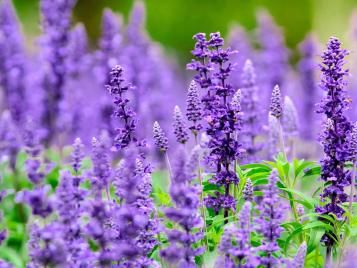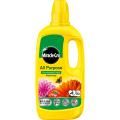

How to grow Salvias
Salvias thrive in a sunny garden and are much loved by wildlife. There are over 900 distinct species of Salvia, providing a huge range of smells and vivacious colours. It can be difficult to choose from so many varieties, so let’s look at some of the different types of Salvia and how to care for these wonderful plants.
Types of Salvias to grow
Salvias are generally grown as annuals, herbaceous perennials, or woody (shrubby) perennials. In the UK they usually flower from July to November, although exactly when varies by the variety.
It is useful to know whether a Salvia is hardy or tender (sometimes referred to as ‘half-hardy’), which describes how well the species can survive freezing temperatures, as extra steps will be needed to protect tender Salvias before frosts arrive.
Some great salvias to consider are:
- Salvia ‘Amistad’. Hardy woody perennial producing purple flowers from May to September.
- Salvia buchananii. Herbaceous tender perennial growing to about 60cm (2') in height. Magenta-coloured flowers from May to September.
- Salvia elegans. Also known as pineapple sage or tangerine sage, owing to the fruity aroma of the leaves. This tender woody perennial produces deep red flowers from June to August.
- Salvia greggii. Tender perennial which flowers from June to October.
- Salvia horminum ‘Claryssa Mixed’. Tender annual producing white, pink and purple flowers from July to September.
- Salvia ‘Hot Lips’. Herbaceous tender perennial. Small but eye-catching white and bright red flowers from July to October.
- Salvia involucrata ‘Bethellii’. Growing to 1.5m (5') tall, this woody tender perennial Salvia produces large bright pink flowers from June to September.
- Salvia nemorosa ‘Caradonna’. Hardy perennial with violet-blue flowers from June to October.
- Salvia officinalis. Common sage, often used in the kitchen. Hardy woody perennial with heavily scented leaves and blue flowers in July and August.
- Salvia rosmarinus. Widely known as rosemary, and a favourite in the kitchen. A hardy woody perennial which flowers from April onwards.
- Salvia splendens ‘Blaze of Fire’. Tender annual producing compact heads of red flowers from June to October.
- Salvia uliginosa. Herbaceous woody perennial which can grow to 1.8m (6') tall. Soft blue flowers from August onwards.
- Salvia viridis ‘Blue’. Vigorous hardy annual with purple flowers from June to August.

What you’ll need to grow Salvias
To grow Salvias you will need:
- Spade (if planting straight into the border)
- Grit
- A plant, cutting or seeds
- Water
- Pot or tray (if planting cuttings or sowing seeds)
- Compost (if planting or sowing into pots or trays)
- Clear plastic bag
Salvias can be bought as plants ready to go straight into the garden:
- Dig a hole large enough to accommodate the rootball of the plant.
- Mix grit into the surrounding loose soil.
- Place the plant in the hole at the same depth as it was in the pot, backfill the soil and water well.
Salvias can be propagated for free by taking a soft-wood cutting from an existing plant. This can be done in mid-spring, or late summer. To do this:
- Identify a healthy non-flowering stem which is 8-9cm (3") long.
- Remove the bottom of the stem just below the lowest set of leaves,
- Remove all side leaves apart from those at the top of the stem.
- Fill a 9cm pot with cutting compost, and water lightly.
- Gently push the cutting into the soil.
- Cover the pot with a clear plastic bag, making sure that the bag does not touch the cutting.
- Move pot to a cool, lightly shaded space under cover.
- Plant cutting out when new growth appears.
Some Salvias, especially annuals, can be cheaply grown from seed sown from February to April:
- Fill a tray with seed compost.
- Sow seeds on the surface of the soil, and cover with a sprinkling of fine compost.
- Place a plastic bag over the pot.
- When large enough to handle, move individual seedlings to 9cm (3') pots filled with compost.
- Plant out from May onwards.
Where to plant and grow your Salvias
Salvias like full sun, although they will tolerate occasional shade. They also need well-drained soil and are drought tolerant. For this reason they are not suited to heavy clay, but will tolerate poor, sandy soils.
A whole border of different Salvias can be stunning, so consider finding space for a collection of different varieties. Alternatively, Salvias can be grown in pots, which makes it easier to bring tender varieties under protection in the winter.

Caring and nurturing for your Salvias
Annual Salvias need little care one established. Lift in the autumn and replace with winter bedding plants.
Woody Salvias should be lightly pruned in the spring, and a second time in summer or early autumn. The second pruning given to woody Salvias has become known as the ‘Hampton Hack’. This is quite a brutal pruning which encourages new growth and tidies any straggly growth. Using sharp secateurs, cut back all growth to about two-thirds of its size. This means that all flower heads and some softwood growth is removed. Chop to just above a set of leaves.
Tender herbaceous Salvias can be pruned in the autumn. Hardy herbaceous perennial Salvias should be pruned once, in the spring or autumn. Using a pair of sharp secateurs, remove the old stems of herbaceous Salvias by cutting them back to just above any fresh green growth.
Tender Salvias are vulnerable to cold weather and need protection from frosts. Dig up and move to a frost-free location in late autumn before replanting in the spring. Take cuttings in case any do not survive.
Deadhead all Salvias throughout the summer to maintain a tidy appearance and promote new flowers.
Mulch perennial Salvias annually with compost, such as Levington® Composted Bark. Salvias in a border do not need feeding, but plants in containers do - use Miracle-Gro® Performance Organics All Purpose Concentrated Liquid Plant Food in the spring.
Common pests and diseases with Salvias
The main challenge for Salvia plants is cold weather. Protect tender perennials before frosts arrive, and take cuttings of all Salvias to ensure you have a supply of replacement plants should any not survive.
Salvias are largely unaffected by most garden pests and diseases - another reason to add this low maintenance plant to your garden!




